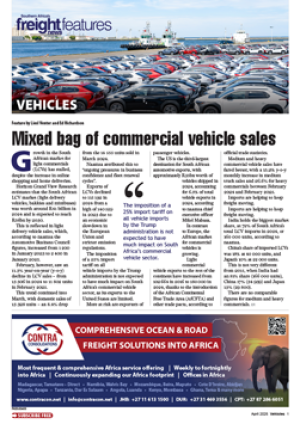1. What about containers being shipped
though SA ports from neighbouring
southern African countries?
The requirement to verify the gross mass
of a container has been communicated
to the Department of International
Relations and Cooperation (Dirco) to
communicate to neighbouring southern
African countries.
2. What about non-conforming
containers under Method 2?
If a shipper is found to have misdeclared
the verified gross mass (VGM) the South
African Maritime Safety Authority (Samsa)
appointed third party will revoke or
suspend the shipper’s Method 2 approval
and it will then be necessary for the
shipper to use Method 1.
Samsa will also investigate where
necessary and this may result in a penalty
(a fine or 12 months’ imprisonment).
3. Will the Method 2 weighing process
of every container be monitored by
the Samsa-appointed third party?
It would be impractical and costly to do
so and it is therefore envisioned that
the verification agency would conduct
an assessment of the shipper’s quality
management system (e.g. ISO 9001 or
similar).This will involve a desktop audit as
well as physical on-site inspections.
4. Is there an agreed format to
communicate verified gross mass?
Solas does not mandate any particular
form of communication between the
parties exchanging the verified gross mass
information.
The information to be provided by the
shipper is the same under Method 1 and
Method 2 and should be signed by the
shipper or a person duly authorised by the
shipper.
The information and signature may
be transmitted electronically, and the
signature may consist of the last name of
the responsible person in capital letters.
5. What about containers shipped
prior to 1 July that are awaiting
transhipment at port terminals?
There has been sufficient communication
with regard to this issue in the past year
for advance planning between the shipper,
shipping line and terminal operator. The
master shipper has the final say and may
arrange for VGM and claim the costs.
6. Does Samsa verify/approve
weighbridges or any weighing
equipment?
No. Weighing equipment must comply
with the requirements of the Legal
Metrology Act 2014, governed by the
National Regulator for Compulsory
Specifications (NRCS).
7. How accurate must the verified gross
mass (VGM) of a container be?
The Solas regulation does not provide
for a margin of error. However, some
cargo products may incur normal, minor
changes in mass from the time of packing
and weighing until delivery (e.g. due to
evaporation or humidity changes) and
some containers’ tare mass may change
over time and vary somewhat from the
tare mass marked on the container.
However, these margins of error should be
minimal and would not normally present
safety concerns.
8. Who is ‘the shipper’ in the context of
this new procedure?
Under the Solas requirements, the
shipper named on the ocean bill of
lading is the party responsible for
providing the maritime (ocean) carrier
(‘master’) and the terminal operator
(‘terminal representative’) with the VGM
of a packed container.
MSC 1 / Circ. 14753 defines ‘the shipper’
as “a legal entity or person named on the
bill of lading or sea waybill or equivalent
multimodal transport document as shipper,
and/or who (or in whose name or on
whose behalf) a contract of carriage has
been concluded with a shipping company.”
Due to the complexity of the international
supply chain, the entity identified as the
‘shipper’ on the bill of lading may not
have direct or physical control over key
elements of the process by which verified
gross mass is determined. A ‘shipper’
in such circumstances should be aware
of his responsibilities and ensure that
arrangements are in place to obtain and
provide a verified gross mass in compliance
with these international and national
regulations.
9. For FCL shipments involving a freight
forwarder there are two different
scenarios:
where the forwarder is the agent
(putting the carrier and shipper in a
direct contractual arrangement); and
where the freight forwarder acts as
principal and issues a house bill of
lading, being named as the ‘shipper’
on the maritime carrier’s bill of lading/
contract of carriage.
In either scenario, can the freight
forwarder rely on the mass provided by the
forwarder’s customer using Method 2?
Internationally, the ‘shipper’ is the entity
named on the maritime carrier’s bill
of lading/contract of carriage. It is the
shipper who is responsible for obtaining
the verified gross mass of the packed
container and for providing it to the
maritime carrier and terminal operator; the
preparation of any documentation needs
to be determined between the commercial
parties involved.
10. If goods are put onto a feeder ship
from, for example, Dar es Salaam
(Tanzania) that proceeds to Durban,
will verified gross mass have to be
established in Dar es Salaam, Durban
or both places?
Verified gross mass is required before
loading the packed container on board
a ship at its initial port of loading, unless
driven onto a ro-ro ship on a chassis or
trailer. Thus, in this question, the verified
gross mass must be determined prior to
loading aboard ship at Dar es Salaam.
Sources: Samsa and IMO
CAPTION
The Cape Town Container Terminal, Cape Town harbour
Frequently asked questions:
01 Jun 2016 - by Staff reporter
0 Comments
FTW - Solas - Booklet - 2016

01 Jun 2016
01 Jun 2016
01 Jun 2016
01 Jun 2016
01 Jun 2016
01 Jun 2016
01 Jun 2016
01 Jun 2016
01 Jun 2016
01 Jun 2016
Border Beat
16 Apr 2025
